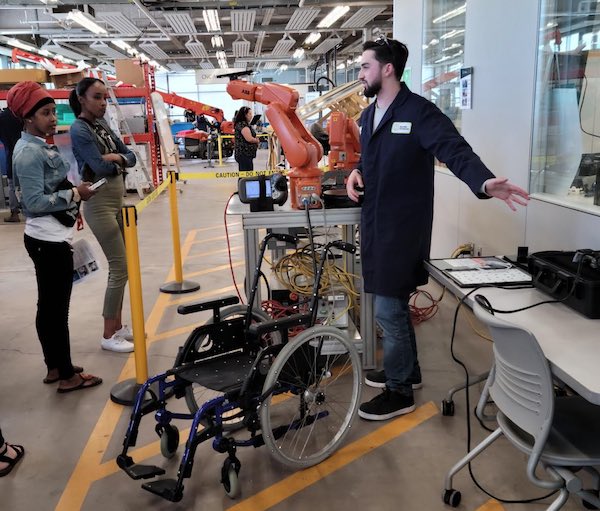Alberta
Financial boost will engage Red Deer Polytechnic with partners working on medical device innovations

Red Deer Polytechnic’s CIM-TAC receives national funding
Two years after being designated a Technology Access Centre through a grant from the Natural Sciences and Engineering Research Council (NSERC), Red Deer Polytechnic’s Centre for Innovation in Manufacturing (CIM-TAC) is celebrating new funding. The national funding – and the equipment it supports – were highlighted at the CIM-TAC Open House, hosted yesterday at the industrial research facility.
“The Open House provided an opportunity for stakeholders and community members to come to CIM-TAC and gain a better understanding of the first-class innovation and opportunities that are available here,” says Jim Brinkhurst, Interim President of Red Deer Polytechnic. “The prestigious grant funding that the CIM-TAC has received over recent years allows us to grow the knowledge, expertise and equipment available to support research and innovation – in central Alberta and beyond.”
NSERC announced in April that the CIM-TAC would receive $300,000 over two years in an Applied Research and Technology Partnership (ARTP) grant to promote the growth of innovations in health care assistive devices in Alberta. CIM-TAC’s business and industry clients will be able to accelerate commercialization of their devices through the addition of engineers and technologists with specialties in mechanics, mechatronics and robotics, as well as students in engineering, business, and health sciences to assist on projects.
“The TAC grant in 2020 allowed us to increase our capabilities to include design engineering and material experts,” says Dr. Tonya Wolfe, CIM-TAC Manager. “The additional staff we’ll be able to take on with the ARTP grant will give us an integrated team of specialists capable of accelerating new product development for our industry clients. Additionally, we will be able to provide a new focus area for central Alberta’s existing manufacturing base, many of whom have already expressed a desire to find areas for new opportunities as the traditional economy of our region changes.”
The majority of medical devices used in our healthcare system are imported. By encouraging the growth of innovations in health care assistive devices in the region, it will enable Alberta’s manufacturers to diversify into this market through the adoption and integration of digital manufacturing, which is key to meeting the changing realities of Alberta’s economy.
“With our enhanced capacity, CIM-TAC is able to provide Alberta’s assistive health care companies an integrated one-stop applied research shop to accelerate the commercialization of their homegrown innovations,” says Wolfe. “Our expertise includes design for manufacturing, validation, and manufacturing optimization – all intended to support SMEs at every stage of the innovation cycle as they focus on improving their manufactured products and processes.”
Darryl Short of Karma Medical Products (KARMED) gave a keynote address at the Open House event about his collaboration with the CIM-TAC in the development of a system for hand and upper extremity therapy. The product assists patients in gaining flexibility, strength, and functional independence. CIM-TAC worked with KARMED on prototyping and in the scale up stage.
“Through our recent funding and the opportunities it provides, Red Deer Polytechnic’s CIM-TAC is positioned to collaborate with innovators and industry to meet an important need across our province,” says Brinkhurst. “We look forward to working with our partners and stakeholders to achieve positive short-term and long-term goals that will benefit Albertans.

About the Centre for Innovation in Manufacturing (CIM-TAC):
While its Technology Access Centre designation was awarded in 2020, the CIM opened in 2009 as one of the key facilities of RDP’s Four Centres. Since then, they have collaborated with hundreds of small and medium sized businesses and entrepreneurs to create solutions to numerous real-world manufacturing challenges. In 2021, the CIM-TAC had more than 500 engagements with business and industry clients interested in applied research and advanced manufacturing. Out of these, 28 new products and processes were developed, and 41 existing products were improved.
Alberta
Made in Alberta! Province makes it easier to support local products with Buy Local program

Show your Alberta side. Buy Local. |
When the going gets tough, Albertans stick together. That’s why Alberta’s government is launching a new campaign to benefit hard-working Albertans.
Global uncertainty is threatening the livelihoods of hard-working Alberta farmers, ranchers, processors and their families. The ‘Buy Local’ campaign, recently launched by Alberta’s government, encourages consumers to eat, drink and buy local to show our unified support for the province’s agriculture and food industry.
The government’s ‘Buy Local’ campaign encourages consumers to buy products from Alberta’s hard-working farmers, ranchers and food processors that produce safe, nutritious food for Albertans, Canadians and the world.
“It’s time to let these hard-working Albertans know we have their back. Now, more than ever, we need to shop local and buy made-in-Alberta products. The next time you are grocery shopping or go out for dinner or a drink with your friends or family, support local to demonstrate your Alberta pride. We are pleased tariffs don’t impact the ag industry right now and will keep advocating for our ag industry.”
Alberta’s government supports consumer choice. We are providing tools to help folks easily identify Alberta- and Canadian-made foods and products. Choosing local products keeps Albertans’ hard-earned dollars in our province. Whether it is farm-fresh vegetables, potatoes, honey, craft beer, frozen food or our world-renowned beef, Alberta has an abundance of fresh foods produced right on our doorstep.
Quick facts
- This summer, Albertans can support local at more than 150 farmers’ markets across the province and meet the folks who make, bake and grow our food.
- In March 2023, the Alberta government launched the ‘Made in Alberta’ voluntary food and beverage labelling program to support local agriculture and food sectors.
- Through direct connections with processors, the program has created the momentum to continue expanding consumer awareness about the ‘Made in Alberta’ label to help shoppers quickly identify foods and beverages produced in our province.
- Made in Alberta product catalogue website
Related information
Alberta
Province to expand services provided by Alberta Sheriffs: New policing option for municipalities

Expanding municipal police service options |
Proposed amendments would help ensure Alberta’s evolving public safety needs are met while also giving municipalities more options for local policing.
As first announced with the introduction of the Public Safety Statutes Amendment Act, 2024, Alberta’s government is considering creating a new independent agency police service to assume the police-like duties currently performed by Alberta Sheriffs. If passed, Bill 49 would lay additional groundwork for the new police service.
Proposed amendments to the Police Act recognize the unique challenges faced by different communities and seek to empower local governments to adopt strategies that effectively respond to their specific safety concerns, enhancing overall public safety across the province.
If passed, Bill 49 would specify that the new agency would be a Crown corporation with an independent board of directors to oversee its day-to-day operations. The new agency would be operationally independent from the government, consistent with all police services in Alberta. Unlike the Alberta Sheriffs, officers in the new police service would be directly employed by the police service rather than by the government.
“With this bill, we are taking the necessary steps to address the unique public safety concerns in communities across Alberta. As we work towards creating an independent agency police service, we are providing an essential component of Alberta’s police framework for years to come. Our aim is for the new agency is to ensure that Albertans are safe in their communities and receive the best possible service when they need it most.”
Additional amendments would allow municipalities to select the new agency as their local police service once it becomes fully operational and the necessary standards, capacity and frameworks are in place. Alberta’s government is committed to ensuring the new agency works collaboratively with all police services to meet the province’s evolving public safety needs and improve law enforcement response times, particularly in rural communities. While the RCMP would remain the official provincial police service, municipalities would have a new option for their local policing needs.
Once established, the agency would strengthen Alberta’s existing policing model and complement the province’s current police services, which include the RCMP, Indigenous police services and municipal police. It would help fill gaps and ensure law enforcement resources are deployed efficiently across the province.
Related information
-

 2025 Federal Election1 day ago
2025 Federal Election1 day agoOttawa Confirms China interfering with 2025 federal election: Beijing Seeks to Block Joe Tay’s Election
-

 Energy2 days ago
Energy2 days agoIndigenous-led Projects Hold Key To Canada’s Energy Future
-

 2025 Federal Election1 day ago
2025 Federal Election1 day agoHow Canada’s Mainstream Media Lost the Public Trust
-

 Energy2 days ago
Energy2 days agoMany Canadians—and many Albertans—live in energy poverty
-

 Business2 days ago
Business2 days agoCanada Urgently Needs A Watchdog For Government Waste
-

 2025 Federal Election15 hours ago
2025 Federal Election15 hours agoBREAKING: THE FEDERAL BRIEF THAT SHOULD SINK CARNEY
-

 2025 Federal Election1 day ago
2025 Federal Election1 day agoReal Homes vs. Modular Shoeboxes: The Housing Battle Between Poilievre and Carney
-

 2025 Federal Election15 hours ago
2025 Federal Election15 hours agoCHINESE ELECTION THREAT WARNING: Conservative Candidate Joe Tay Paused Public Campaign



